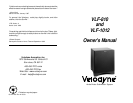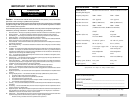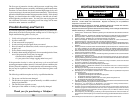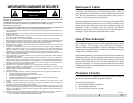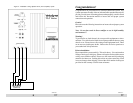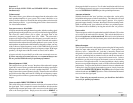
continued. . .
disengage the built in crossover. For all other installations which do not
have a separate electronic crossover, we recommend you leave the internal
crossover INTERNAL X-OVER to provide optimum performance.
Auto turn on function
With this function in the "auto" position, your subwoofer can be safely
left with the main power switch on continuously. The subwoofer will turn
itself on automatically when an audio signal is present. If no signal is
present for approximately 7 minutes, the unit will switch to standby mode.
While in standby mode, your subwoofer will draw very minimal power.
This function can be disabled by leaving the switch in the "on" position.
Power switch
The master power switch is located on the lower half of the unit. This rocker
style switch is the main on/off for the unit. This switch should be set to
position 1 (up) for on, and 0 (down) for off. If the unit is to be left unused
for an extended period of time, the master power switch should be turned
off.
Important!!!
Do not use both LINE LEVEL and SPEAKER LEVEL connections
simultaneously!
Volume control
This control allows you to balance the output from the subwoofer to the
main speakers/amplifier in your system. This control should be set to
achieve similar output level from both the main speakers and subwoofer
when listening to music. A good starting point for the volume control is
3 or 4 dots from minimum.
Low-pass crossover - 40 to 120Hz
All inputs sum the left and right channels together, with the resulting signal
passing through an adjustable low-pass crossover before being amplified.
The crossover control allows you to adjust the upper limit of the
subwoofer's frequency response from 40 to 120Hz. The subwoofer's
response will begin rolling off above the frequency you set this control to.
You should set the crossover frequency to obtain a smooth and seamless
transition from the subwoofer to the main speakers in your system. If your
main speakers are smaller units with limited low frequency output, you may
wish to choose a higher frequency (such as 100-120Hz) than you would
with larger speakers which have greater low frequency output. With larger
speakers, you might start with this control set lower, such as 80Hz.
A bypass switch is also provided if you wish to use an external crossover.
If you are not using an external crossover, we recommend that you use
the one provided within the unit for optimum performance!
Phase adjustment - 0
°
/180
°
This control allows you the "reverse" the phase of the subwoofer's output
signal 180
°
to correct for any possible mismatch and resulting cancellation
between the subwoofer and your main speakers/amplifier. To adjust,
simply listen to the system with music playing. Then move the switch from
one position to the other and listen for a change in low frequency output.
The correct position will have a greater amount of apparent low frequency
output.
Crossover switch - DIRECT/INTERNAL X-OVER
This switch allows the electronic crossover circuitry to be removed from
the signal path. This is required in certain installations which route the
signal through external processors with a crossover circuit of their own,
such as the new digital units. Simply move the switch to DIRECT to
continued. . .
4
☞
5
☞
Subwoofer outputs
The Velodyne subwoofer is designed to operate using the full range audio
signal for input when using the built-in crossover. Some processors/
receivers, have a "subwoofer out" jack that is internally filtered and
designed to be used with a conventional amplifier and speaker. In some
rare cases, combining both an external crossover and the one internal to
the subwoofer may result in low output and increased noise. In these
installations you may need to bypass the internal crossover in either the
processor or Velodyne subwoofer. In some installations, simply setting
one crossover to a higher frequency (such as 120 Hz) will restore maximum
performance. To bypass the subwoofer's internal crossover when the unit
is being fed a low pass signal from another crossover, simply locate the
switch marked DIRECT/INTERNAL X-OVER on the rear panel of the
subwoofer and set to the DIRECT position. This will eliminate the internal
crossover from the signal path.
Note: If not using an external crossover, you should use the built-in
crossover for optimal performance.



